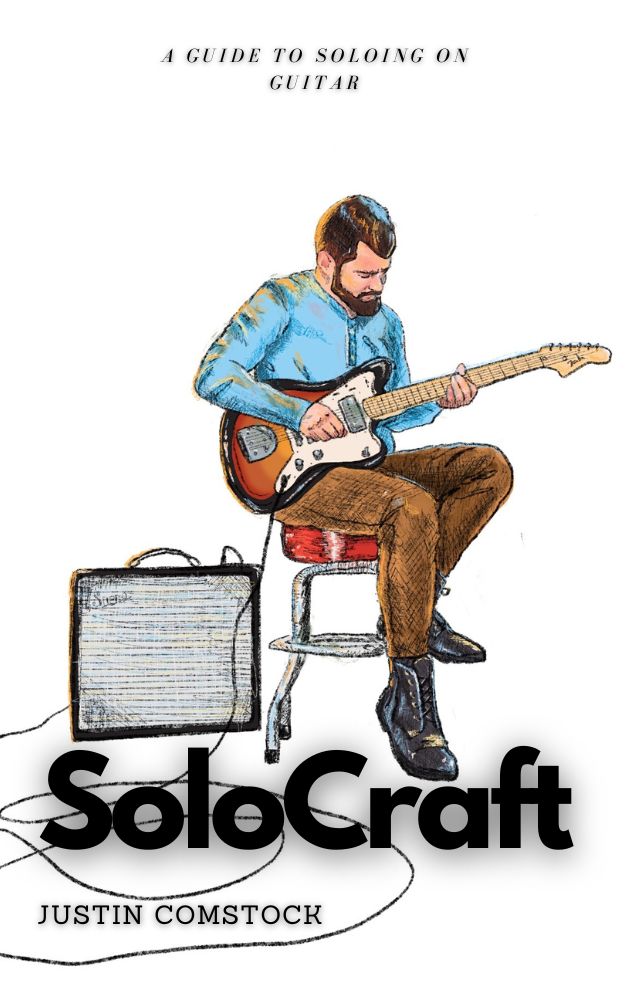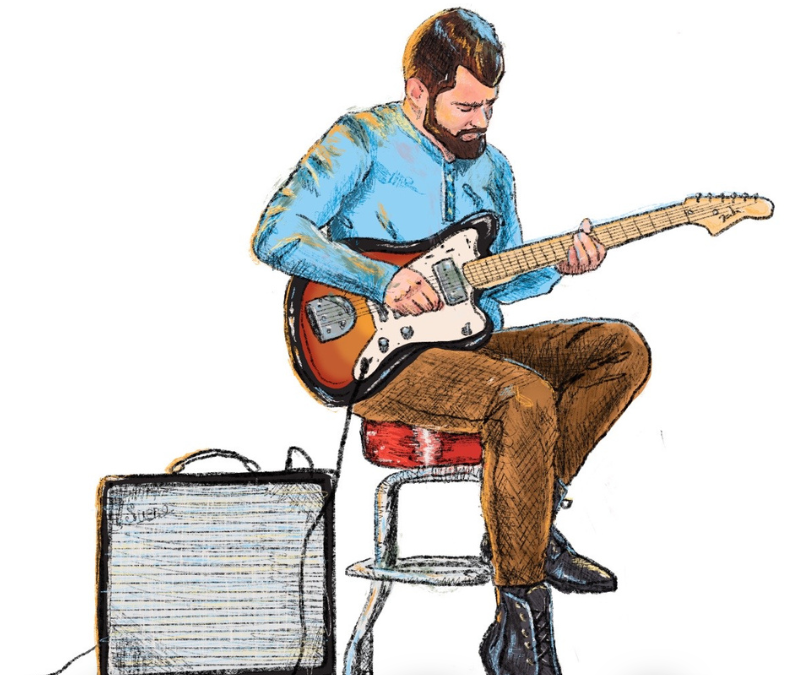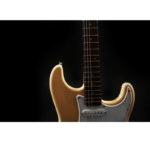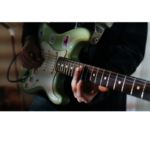I’m thrilled to announce the release of my new book, SoloCraft™, your guide to unlocking the fretboard and crafting a guitar solo that actually say something. Whether you’re just starting or looking to break out of stale licks, this isn’t just another theory book—it’s a blueprint for fretboard fluency, phrasing mastery, and expressive soloing.
And in this post, we’re going to take a deep dive into Chapter 1: Decoding the Fretboard—where your journey to guitar solo mastery begins.
Why the Fretboard Is the Gatekeeper of Great Guitar Solos
You can’t solo like B.B. King, Clapton, or John Mayer if you’re lost on the neck. A great guitar solo starts with knowing where you are. Chapter 1 of SoloCraft™ gives you a clear, bite-sized system to internalize the fretboard, connect scale positions, and see music—not math—on the guitar.
But if you’re struggling with fretboard visualization, you’re not alone—and that’s exactly why I also built FretDeck™.
👉 Back FretDeck™ on Kickstarter and join thousands of guitarists decoding the neck, one card at a time.

❌ Stop Guessing. Start Shredding.
If you’re still fumbling through scale patterns and box shapes… it’s costing you progress.
FretDeck™ is the no-fluff system that shows you exactly how to master the fretboard—fast. Early access.
⚡️ This isn’t for dabblers. It’s for players who want results.
👉 Click here to join the pre-launch now
Early access. Limited rewards. Don’t wait.
The Problem: The Fretboard Feels Like a Maze
Most guitarists stare at the fretboard like it’s a puzzle someone else solved. Scales feel mechanical. Positions feel disconnected. A guitar solo becomes memorized shapes and guesswork.
The Fix: A Layered, Visual Approach
Chapter 1 starts by eliminating the noise. You’ll learn:
- Where root notes live
- How patterns flow together
- How to see chords inside scale shapes
- And how to build guitar solos that breathe
Let’s break down the four major concepts you’ll explore.
1. The Root Note Is Your North Star
If you can find the root, you can find the key. You can start a phrase that means something.
Example: A Minor Pentatonic Root Notes
- 5th fret on the low E (A)
- 7th fret on the D (A)
- 10th fret on the B (A)
Knowing these across the fretboard means you’re never flying blind again.
2. Connecting Patterns = Total Neck Access
Ever feel trapped in one position? That’s because you are. Most players only use one or two shapes and never link them.
SoloCraft™ teaches you how to connect all five pentatonic shapes—and more.
Example:
- Start in Pattern 1 (5th fret, A minor)
- Slide into Pattern 2 (8th fret)
- Link to Pattern 3 (10th–12th fret)
No more stop-and-go phrases. Your guitar solos will flow. Seamlessly.
Want to strengthen your scale practice routine? Check out our post on 5 guitar scales to practice that will actually make you a better player.
3. Chords and Scales Aren’t Separate
Most players separate chords from scales in their mind. Chapter 1 flips that.
By learning to see chords inside scales, you’ll:
- Hit chord tones that make your solos sound intentional
- Outline the harmony even while improvising
- Avoid that “just running the scale” sound
Example: A minor chord = A, C, E. Target those notes while crafting a guitar solo and you’re immediately more melodic.
4. Use the CAGED System Like a Pro
CAGED isn’t just for chords—it’s your fretboard map.
SoloCraft™ shows how to:
- Align CAGED shapes with scale positions
- Play arpeggios through chord changes
- Solo over the neck in any key with confidence
C Major with CAGED:
- C shape: Open
- A shape: 3rd fret
- G shape: 5th–7th fret
Use this system and your guitar solos will suddenly make sense from any angle on the neck.
🎸 Enter FretDeck™ – The Fastest Way to Master the Neck
FretDeck™: Pentatonic Scales Edition is the tool I created after watching hundreds of students struggle with the same thing: connecting what they know with what they play.
Each card in the deck helps you visualize scale shapes, root positions, and modal variations across all 12 keys.
✅ 60 Visual Cards (5 shapes × 12 keys)
✅ Built-in Practice Prompts
✅ Bonus Mini-Course: Pentatonic Secrets
✅ Join the private Guitar Freaks Hangout Discord for jam tracks, feedback, and prompts
🔥 This isn’t fluff. It’s a roadmap. 👉 Back the Kickstarter Now 👉 Join the Guitar Freaks Hangout on Discord and get a FREE copy of Fret Logic

❌ Stop Guessing. Start Shredding.
If you’re still fumbling through scale patterns and box shapes… it’s costing you progress.
FretDeck™ is the no-fluff system that shows you exactly how to master the fretboard—fast. Early access.
⚡️ This isn’t for dabblers. It’s for players who want results.
👉 Click here to join the pre-launch now
Early access. Limited rewards. Don’t wait.
From Fretboard Knowledge to Guitar Solo Artistry
Chapter 1 doesn’t stop at scales and systems. It sets you up for what matters: sound.
🎵 Phrasing and Melodic Thinking
Repetition. Variation. Bends. Vibrato. All taught through hands-on prompts.
“SoloCraft” trains your musical instincts—not just your fingers—so your guitar solos connect with your audience.
🎯 Chord Tone Targeting
Hit the root, 3rd, or 5th of the chord in your guitar solo and suddenly, you sound like a composer—not a scale-runner.
👂 Develop Your Ear
You’ll learn simple call-and-response prompts to develop your melodic ear and break free from scale memorization. Your solos will sound less like exercises and more like statements.
💡 Combine Emotion + Technique
Speed is meaningless without emotion. You’ll practice slow, soulful licks with dynamic control, then learn how to ramp up intensity—only when the guitar solo calls for it.
Ready to Solo Like You Mean It?
Whether you’re a beginner breaking into improvisation or a seasoned player trying to level up, SoloCraft™ gives you the edge.
Chapter 1 is just the start.
👉 Download SoloCraft™ Now
👉 Back FretDeck™ on Kickstarter
👉 Join Guitar Freaks Hangout on Discord and grab your FREE copy of Fret Logic
Let’s unlock the neck—and unleash your next great guitar solo.

Download the ebook “SoloCraft”!
SoloCraft is the ultimate guide to mastering guitar soloing, designed for players of all levels. Packed with step-by-step lessons, pro-level techniques, and real-world examples, SoloCraft teaches you how to navigate the fretboard, craft expressive solos, and unlock your full potential as a lead guitarist. Whether you’re improvising, building speed, or adding emotion to your playing, SoloCraft gives you the tools to solo like a pro.
Download Now










